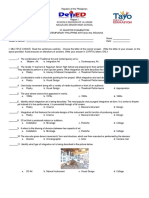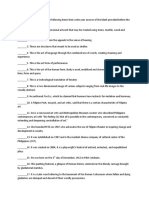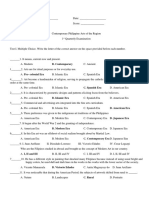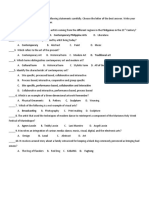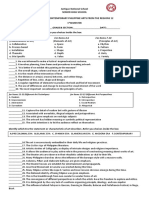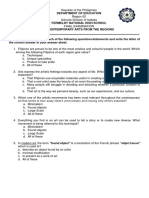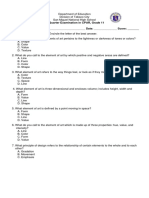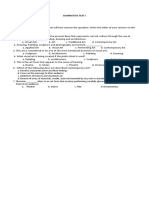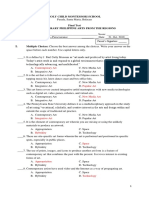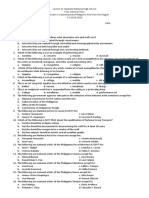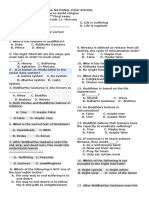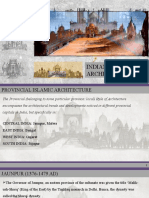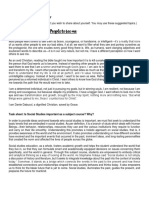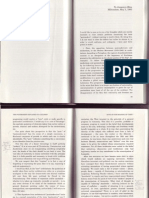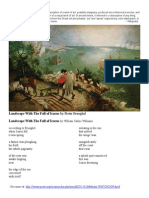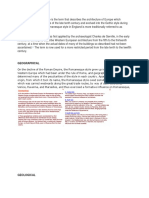Professional Documents
Culture Documents
CPAR Long Test
CPAR Long Test
Uploaded by
Iekzkad RealvillaOriginal Description:
Original Title
Copyright
Available Formats
Share this document
Did you find this document useful?
Is this content inappropriate?
Report this DocumentCopyright:
Available Formats
CPAR Long Test
CPAR Long Test
Uploaded by
Iekzkad RealvillaCopyright:
Available Formats
Contemporary Philippine Arts from the Regions
Read all the items carefully and write the letters of the correct answers.
1. What do you call the law that institutionalized GAMABA?
a. R. A. 7355 b. R.A. 7533 c. R.A. 7553 d. R.A. 5733
2. Sinulog festival is an example of art in Cebu. In what art form does the festival belong?
a. dance b. literature c. music d. performing arts
3. How can you make your artwork appealing to the viewers?
a. I will employ the different elements and principles of art.
b. I will use variety of colors.
c. I will use mixed media.
d. I will share my expertise to them.
4. What is a wooden bench that marks the socio economic status of the owner?
a. Hagabi b. Pisyabit c. Tapayan d. Bul-ul
5. What do you call a fabric made up of fine abaca fibers weaved with different designs which reflect the tradition of the T’boli?
a. Inabal b. T’nalak c. Mat d. Bagobo
6. One of the general characteristics of the contemporary artist is site-specific. Which of the following best describes the characteristic?
a. They continue to use traditional and mixed media
b. They cannot experience in the same way when remove from their original places of exhibit.
c. They integrate various art forms
d. They are generally process-based.
7. What do you call a poem consisting of seven-syllable lines which most of the time contains messages of love and friendship?
a. Ambahan b. Gimbal c. Tmabilaw d. Sugidanon
8. How festival is related to art?
a. Festival promotes the rich culture of the place.
b. It makes use of the elements of art.
c. It employs creativity and resourcefulness.
d. All of the above.
9. Which of the following is the most significant role of the artists from the regions?
a. They create avenues to advocate the arts from the different regions.
b. They promote mastery and enhancement of skills.
c. They promote tourism of the regions.
d. They help the local economy.
10. The “art of the so called past” continued and continues to evolve until the present and is therefore in the sense of art is__________?
a. Historical b. stylistic c. cultural d. contemporary
11. DarhatSawabi :Pis-yabit, Lang Dulay : _________________.
a. Inabel weaving c. T’nalak weaving
b. Mat weaving d. gourd casque making
12. Which of the following major cultural offices determined the GAMABA awardees?
a. NCAA and CCP c. CCP and NCCA
b. NAA and NCAA d. MTRCB and KALIBAPI
(I.)Teofilo Garcia, a 2012 GAMABA awardee is a farmer in the town of San Quintin, Abra province, better known for tending a plot of land filled
with enlarged upo or gourd. After planting the upo in November and harvesting the mature fruits in summer, (II.) Garcia would transform the
harvest into durable hats. (III) Simple hand tools are used to gouge the inside of tabungaw. (IV) Garcia was instrumental in fortifying the tradition
through six decades worth of persistent practice. (V) His artistic rendering of a functional object dedication to craft and commitment to the
community make him a bearer of culture. (VI) In recent years, he initiated training for students at San Quintin National High School to pass the
knowledge and skills of tabungaw hat making, inspiring the youth to value the tradition and ensure its upkeep.
Choices from items 13-16.
a. I b. II c. III d. IV e. V f. VI
13. What sentence shows that artist possesses mastery of tools?
14. What sentence proves that the awardee is a member of an indigenous/cultural community?
15. What sentence states that the awardee has passed on to other members of the community the skills in folk art where the community is
known?
16. What sentence states that the artist has engaged in the tradition that has been in existence and documented for at least 50 years?
17. The story of Teofilo Garcia proved the idea that_________?
a. Contmeporary is traditional art or vice versa.
b. Traditional art is art of the past.
c. Anyone can be a national living treasure.
d. Contemporary art is fixed.
18. As a student how can you create a work that promote traditional art with local practitioners?
a. I will make and use the product.
b. I will visit a gallery or museum.
c. I will go the place of the artist, buy the products and sell them in my locality.
d. I will conduct a workshop using my knowledge, talents, skills and expertise in making quality products using available indigenous
materials in the locality.
Choices from items 22-27
a. line b. color c. shape d. texture e. hue f. space and movement
19. It exist as an “illusion” in the graphic arts , but in sculpture and architecture, it is present.
20. Refers to the feel or tactile quality surface of an object.
21. It give spatial quality to the pictorial field, has ability to arouse sensations of pleasure and it may create mood and symbolizes ideas and
express personal emotions.
22. It is an area on flat surface enclosed by a line, can be used to simplify ideas it may be natural, abstract, non-objective or geometric.
23. The artist uses this elements of art to imitate or to represent objects and figures on a flat surface.
24. The quality which gives a color its name.
Choices from items 19-21( Identify the following)
a. Medium b. Subjects c. form
25. It refers to any person, objects, scene or event described or represented in a work of art?
26. It refers to the physical qualities or characteristics of the image?
27. It refers to the material or means which the artist uses to objectify his feeling or thought?
28. It is an artistic work or practice that uses digital technology as an essential part of the creative process?
a. land art b. graffiti c. collage d. digital art
29. It is an art form that is created in nature, using natural materials such as soil,rock organic media and water which introduced materials
such as concrete metal asphalt or mineral pigments?
a. land art b. graffiti c. collage d. digital art
30. It is drawing or writings that have been scribbled, scratched or painted illicitly on a wall or other surface often in public space?
a. land art b. graffiti c. collage d. digital art
31. The French word Decollage in English means ____________?
a. Take in b. to become glued c. to become stuck d. take off
32. It is the technique of an art production made from on assemblage of different forms include magazines and newspaper clippings, ribbons,
or handmade papers, texts, photographs or other objects glued to a piece of paper or canvas.
a. collage b. decollage c. colleague d. recollage
33. When do we consider a person who belongs to the higher status of the Ifugao society?
a. kampilan b. kadanagyan c. bagobo d. sarimanok
34. Which is not an element of art?
a. line b. color c. form d. harmony
35. what is the term refer to a rice wine drinking ceremony?
a. tambilaw b. yakan c. bagit d. tinapay
36. which is an arrowroot cookie that has the image of St. Nicholas?
a. puni b. sanikulas c. taka d. pabalot
37. What do you call a ritual of collective cooking and sharing of rice which is a ritual offering to the Lord of Rice?
a. tambilaw b. tinapay c. kulilal d. yakan
38. In the past, what is the most common form of housing to native Filipinos made of bamboo, cogon grass and nipa palm leaves?
a. bahaykubo b. bahaynabato c. bahay-bahayan d. bahayampunan
39. An exotic Philippine art form based on early century technique graffito.
a. Kat-kat art b. Kut-kut art c. Islamic arts d. Performing arts
40. The hagabi shapes at present, which is like the head of an animal with an elongated nose and two big ears is called?
a. ginulding-gulding b. ngiwi c. malong d. Okir
41. When do we consider a person who belongs to the higher status of the Ifugao society?
b. kampilan b. kadanagyan c. bagobo d. sarimanok
42. What is a wooden figure usually perched atop of a bamboo pole, stands among decorative flags during weddings and festive occasions?
a. sarimanok b. ginulding-gulding c. ngiwi d. malong
Test II. Match column A and B. Write your answer on the blank spaces below the table.
A. ARTIST B. CONTRIBUTION
________43.GinawBilog A. Basal. Kulila, Bagil
________44.Alonzo Saclag B.Ambahan
________45.MansinoIntaray C. Epic Chanting
________46. Federico Caballero D.PisYabit
________47. SamanonSulaiman E. KwintanganKayu
________48. DahrataSawabi F. Abel
________49. Lang Dulay G.Tambungaw
________50.Magdalena Gamayo H. Mat weaver
________51.UwangAhadas I. Kutyapi
________52.HajaAminaAppi J. T’nalak
________53.Eduardo Mutuc K. Bagobo fabrics
________54.Teofilo Garcia L. Kalinga budong dance
________55. SalitaMonon M. wood carving/metal art
N. Painting
You might also like
- 1st Quarter Examination Contemporary ArtsDocument4 pages1st Quarter Examination Contemporary Artsnicky tampoc92% (13)
- CPAR-diagnostic 2019-2020Document2 pagesCPAR-diagnostic 2019-2020Onecup Rice50% (4)
- Philippine Contemporary Art Quiz 1Document1 pagePhilippine Contemporary Art Quiz 1Virgilio Rosario Biagtan80% (20)
- Pretest Contemporary Arts From The RegionDocument1 pagePretest Contemporary Arts From The RegionJerlyn Mae Sales Quiliope100% (3)
- 1st Periodical Exam in CPAR ANSWER KEYDocument3 pages1st Periodical Exam in CPAR ANSWER KEYRS Dulay60% (5)
- First Midterm Exam in Contemporary Philippine Arts in The RegionsDocument3 pagesFirst Midterm Exam in Contemporary Philippine Arts in The RegionsRustomGaton89% (18)
- Contemporary Arts 1st Quarter ExamDocument4 pagesContemporary Arts 1st Quarter Examedward Ayala75% (12)
- Cpar Diagnostic TestDocument3 pagesCpar Diagnostic TestArman Cambe100% (2)
- Cpar PPT Lesson 3 Various Art FormsDocument47 pagesCpar PPT Lesson 3 Various Art Formsjaslor80% (5)
- CPAR Periodical Exam 2nd QuarterDocument2 pagesCPAR Periodical Exam 2nd QuarterJoseph Gacosta100% (1)
- 1st Quarter Exam in Contempo..Document2 pages1st Quarter Exam in Contempo..May-Ann S. Cahilig100% (9)
- Final Examination in Contemporary ArtsDocument8 pagesFinal Examination in Contemporary ArtsClifford LachicaNoch keine Bewertungen
- CPAR 4th Quarter ExamDocument4 pagesCPAR 4th Quarter ExamVergel Felicia67% (3)
- Cpar Nat'l Artist Summative TestDocument4 pagesCpar Nat'l Artist Summative TestIekzkad Realvilla100% (1)
- Contemporary Arts Exam 3rd QuarterDocument4 pagesContemporary Arts Exam 3rd QuarterJohnsun Galado100% (1)
- Contemporary Midterm ExamDocument5 pagesContemporary Midterm ExamSheenLibarnesYparraguirre100% (4)
- Final Exam Contemporary ArtsDocument2 pagesFinal Exam Contemporary ArtsGlenda Ortillano Lee89% (9)
- Summative Test Contemporary Philippine Art For The Regions I-Multiple Choice. Write Your Answer in The Space ProvidedDocument2 pagesSummative Test Contemporary Philippine Art For The Regions I-Multiple Choice. Write Your Answer in The Space ProvidedMaria Macel90% (10)
- Pre Test in CPARDocument2 pagesPre Test in CPARJeffReyT.Ausan100% (3)
- Business Finance Lesson 3Document34 pagesBusiness Finance Lesson 3Iekzkad RealvillaNoch keine Bewertungen
- CBN WheelDocument49 pagesCBN WheelAbdulNoch keine Bewertungen
- S.K. Pendatun Ave., Mo. Poblacion, Cotabato CityDocument3 pagesS.K. Pendatun Ave., Mo. Poblacion, Cotabato CitySarah Abas LptNoch keine Bewertungen
- Second Quarter Examination in CPARDocument3 pagesSecond Quarter Examination in CPARZenaida Hipolito100% (5)
- CPAR Grade 12 2nd Quarter Final ExamDocument3 pagesCPAR Grade 12 2nd Quarter Final ExamIekzkad Realvilla88% (8)
- FINAL EXAM - Contemporary ArtsDocument8 pagesFINAL EXAM - Contemporary ArtsMaricel Diapana80% (5)
- First Quarter Exam in CparDocument4 pagesFirst Quarter Exam in CparZENAIDA HIPOLITO100% (2)
- CPAR 12-2ND Quarter Summative Test (2022)Document3 pagesCPAR 12-2ND Quarter Summative Test (2022)Ada Ricana100% (3)
- Cpar 12 Assessment Q1Document6 pagesCpar 12 Assessment Q1HENJEL PERALESNoch keine Bewertungen
- CONTEMPORARY PHIL ARTS FROM REGION - Final ExamDocument4 pagesCONTEMPORARY PHIL ARTS FROM REGION - Final Exammyrna100% (1)
- THIRD QUARTER Contemporary ArtsDocument4 pagesTHIRD QUARTER Contemporary Artsrod100% (1)
- CPAR 3rd Quarter ExamDocument3 pagesCPAR 3rd Quarter ExamSORAHAYDA ENRIQUEZ100% (1)
- Schools Division Office I Pangasinan Magalong National High SchoolDocument4 pagesSchools Division Office I Pangasinan Magalong National High SchoolRichard Baysic100% (1)
- Cpar Summative Assessment G12 Quarter 1 Week 1 and 2Document3 pagesCpar Summative Assessment G12 Quarter 1 Week 1 and 2alyana angeles33% (3)
- First Quarter Examination Core 12 - Cpar Contemporary Philippine Arts From The Region S.Y. 2020 - 2021Document5 pagesFirst Quarter Examination Core 12 - Cpar Contemporary Philippine Arts From The Region S.Y. 2020 - 2021Nik BiadoNoch keine Bewertungen
- Department of Education: Malixi Integrated SchoolDocument3 pagesDepartment of Education: Malixi Integrated SchoolFlomarie Alferez100% (3)
- C.A 4rth Periodical Test Answer KeyDocument2 pagesC.A 4rth Periodical Test Answer KeyBern PabNoch keine Bewertungen
- Midterm CPARDocument4 pagesMidterm CPARRubs AD92% (12)
- Sultan Naga Dimaporo Memorial Integrated SchoolDocument3 pagesSultan Naga Dimaporo Memorial Integrated SchoolEmee Marieson BelvisNoch keine Bewertungen
- Contemporary Arts of The Region ExamDocument2 pagesContemporary Arts of The Region ExamArnel Boholst100% (1)
- Quarter 1 Exam - Set A - CparDocument3 pagesQuarter 1 Exam - Set A - CparKarla Jenica PatlunagNoch keine Bewertungen
- 1st Quarter Test in CPAR 11.docx2 - To Be CheckedDocument10 pages1st Quarter Test in CPAR 11.docx2 - To Be CheckedAureanice Z. Bitas0% (1)
- Mditerm Exam in Contemporary Arts 2019-2020Document6 pagesMditerm Exam in Contemporary Arts 2019-2020Clifford LachicaNoch keine Bewertungen
- Philippine Contemporary Arts Quiz 2Document1 pagePhilippine Contemporary Arts Quiz 2Virgilio Rosario BiagtanNoch keine Bewertungen
- Cpar 1ST QTRDocument4 pagesCpar 1ST QTRJohnArgielLaurenteVictor100% (1)
- Final Exam in Cpar 2018-2019Document3 pagesFinal Exam in Cpar 2018-2019Lhen Unico Tercero - Borja100% (4)
- Cpar Summative Test I Q3Document1 pageCpar Summative Test I Q3Char Layi100% (4)
- Contemporary Arts ExamDocument5 pagesContemporary Arts ExamJennifer RegnerNoch keine Bewertungen
- CPAR 2019 SummativeDocument2 pagesCPAR 2019 SummativeJeffrey Pacayra75% (4)
- Midterm Examination in Contemporary Philippine Arts From The RegionDocument2 pagesMidterm Examination in Contemporary Philippine Arts From The RegionArianne Kay Javier-Waban100% (1)
- Contemporary Philippine Arts From The Region - Grade12-Quarter-2-Week5Document7 pagesContemporary Philippine Arts From The Region - Grade12-Quarter-2-Week5Rutchel100% (1)
- Exam in Contemporary Arts 1st MidtermDocument2 pagesExam in Contemporary Arts 1st Midtermcherrie r. de guzman100% (2)
- CPAR 2nd Quarter Exam ANSWER KEYDocument1 pageCPAR 2nd Quarter Exam ANSWER KEYIekzkad Realvilla0% (3)
- Contemporary Philippine Arts From The Region 4 Summative Test SY 2020-2021 NAME: - SECTIONDocument1 pageContemporary Philippine Arts From The Region 4 Summative Test SY 2020-2021 NAME: - SECTIONMary MAy Matabang100% (1)
- Midterm CPAR Test QuestionaireDocument4 pagesMidterm CPAR Test QuestionaireRubs AD100% (1)
- Summative Exam in ContemporaryDocument3 pagesSummative Exam in ContemporaryJerema Joy Reyes MalayoNoch keine Bewertungen
- Q1 Exam Contemporary Philippine Arts From The Regions CDocument2 pagesQ1 Exam Contemporary Philippine Arts From The Regions CPryamn JoefNoch keine Bewertungen
- First Quarter Examination in CparDocument3 pagesFirst Quarter Examination in CparZenaida Hipolito100% (1)
- Finals ContempoDocument4 pagesFinals ContempoKate Molina100% (2)
- CPAR-Reviewer-2nd-Quarter - Answer KeyDocument6 pagesCPAR-Reviewer-2nd-Quarter - Answer KeyJaeyun SimNoch keine Bewertungen
- CPAR Pre-AssessmentDocument5 pagesCPAR Pre-Assessmentirene.lumambas001Noch keine Bewertungen
- CPARDocument5 pagesCPARREDSKIN TravelNoch keine Bewertungen
- ContemporaryDocument6 pagesContemporaryJoeselyn ViceraNoch keine Bewertungen
- Sermon Don't Run Your Mouth!Document17 pagesSermon Don't Run Your Mouth!Iekzkad RealvillaNoch keine Bewertungen
- Desire of Ages Chapter 38Document3 pagesDesire of Ages Chapter 38Iekzkad RealvillaNoch keine Bewertungen
- Desire of Ages Chapter-33Document3 pagesDesire of Ages Chapter-33Iekzkad Realvilla100% (1)
- A Strong Refuge Is Our GodDocument4 pagesA Strong Refuge Is Our GodIekzkad Realvilla100% (1)
- Cesc Q4 WW1Document1 pageCesc Q4 WW1Iekzkad RealvillaNoch keine Bewertungen
- EntrepreneurDocument1 pageEntrepreneurIekzkad RealvillaNoch keine Bewertungen
- Desire of Ages Chapter-32Document3 pagesDesire of Ages Chapter-32Iekzkad RealvillaNoch keine Bewertungen
- Desire of Ages Chapter-37Document3 pagesDesire of Ages Chapter-37Iekzkad Realvilla0% (1)
- Desire of Ages Chapter - 36Document3 pagesDesire of Ages Chapter - 36Iekzkad RealvillaNoch keine Bewertungen
- Cesc Q3 WW3Document1 pageCesc Q3 WW3Iekzkad RealvillaNoch keine Bewertungen
- CESC Q3 - Written Works 1Document1 pageCESC Q3 - Written Works 1Iekzkad RealvillaNoch keine Bewertungen
- CESC Q3 - Written Works 2Document1 pageCESC Q3 - Written Works 2Iekzkad RealvillaNoch keine Bewertungen
- Social WellDocument8 pagesSocial WellIekzkad RealvillaNoch keine Bewertungen
- Desire of Ages Chapter 34Document3 pagesDesire of Ages Chapter 34Iekzkad RealvillaNoch keine Bewertungen
- Is Jesus Really Coming Back To EarthDocument9 pagesIs Jesus Really Coming Back To EarthIekzkad RealvillaNoch keine Bewertungen
- Business Finance Lesson 2Document20 pagesBusiness Finance Lesson 2Iekzkad RealvillaNoch keine Bewertungen
- Book ReviewDocument4 pagesBook ReviewIekzkad RealvillaNoch keine Bewertungen
- PLANETARY NETWORKS NotesDocument2 pagesPLANETARY NETWORKS NotesIekzkad RealvillaNoch keine Bewertungen
- ITWR QuizDocument6 pagesITWR QuizIekzkad RealvillaNoch keine Bewertungen
- Business Finance Pre - Test and Lesson 1Document29 pagesBusiness Finance Pre - Test and Lesson 1Iekzkad RealvillaNoch keine Bewertungen
- Department of Education: Weekly Home Learning Plan 21st Century Literature From The Philippines and The World Week 3Document1 pageDepartment of Education: Weekly Home Learning Plan 21st Century Literature From The Philippines and The World Week 3Iekzkad RealvillaNoch keine Bewertungen
- You Attitude Exercise: "I Would Love To Meet Up With You! How Does Tuesday Sound?"Document2 pagesYou Attitude Exercise: "I Would Love To Meet Up With You! How Does Tuesday Sound?"Iekzkad RealvillaNoch keine Bewertungen
- I. Objectives The Learners Demonstrate An Understanding Of: The Learners Shall Be Able To: The LearnersDocument3 pagesI. Objectives The Learners Demonstrate An Understanding Of: The Learners Shall Be Able To: The LearnersIekzkad Realvilla100% (1)
- I. Objectives The Learners Demonstrate An Understanding Of: The Learners Shall Be Able To: The LearnersDocument3 pagesI. Objectives The Learners Demonstrate An Understanding Of: The Learners Shall Be Able To: The LearnersIekzkad RealvillaNoch keine Bewertungen
- I. Objectives The Learners Demonstrate An Understanding Of: The Learners Shall Be Able ToDocument3 pagesI. Objectives The Learners Demonstrate An Understanding Of: The Learners Shall Be Able ToIekzkad RealvillaNoch keine Bewertungen
- I. Objectives The Learners Demonstrate An Understanding Of: The Learners Shall Be Able To: The LearnersDocument4 pagesI. Objectives The Learners Demonstrate An Understanding Of: The Learners Shall Be Able To: The LearnersIekzkad RealvillaNoch keine Bewertungen
- I. Objectives The Learners Demonstrate An Understanding Of: The Learners Shall Be Able ToDocument3 pagesI. Objectives The Learners Demonstrate An Understanding Of: The Learners Shall Be Able ToIekzkad RealvillaNoch keine Bewertungen
- I. Objectives The Learners Demonstrate An Understanding Of: The Learners Shall Be Able To: The LearnersDocument3 pagesI. Objectives The Learners Demonstrate An Understanding Of: The Learners Shall Be Able To: The LearnersIekzkad RealvillaNoch keine Bewertungen
- I. Objectives The Learners Demonstrate An Understanding Of: The Learners Shall Be Able To: The LearnersDocument3 pagesI. Objectives The Learners Demonstrate An Understanding Of: The Learners Shall Be Able To: The LearnersIekzkad RealvillaNoch keine Bewertungen
- Aegeum 18 First DayDocument6 pagesAegeum 18 First DayAngelo_ColonnaNoch keine Bewertungen
- Metal SpinningDocument3 pagesMetal SpinningOdebiyi StephenNoch keine Bewertungen
- Musyawarah Kerja Kepala Sekolah (MKKS) Sma Ulangan Umum Mid Semester GenapDocument7 pagesMusyawarah Kerja Kepala Sekolah (MKKS) Sma Ulangan Umum Mid Semester GenapWinda MentariNoch keine Bewertungen
- Musical OrnamentationDocument5 pagesMusical OrnamentationvinaNoch keine Bewertungen
- Traditional CraftmanshipDocument6 pagesTraditional CraftmanshipJoy Cabo AbrogueñaNoch keine Bewertungen
- Perspective and CompositionDocument37 pagesPerspective and Compositionapi-262378299Noch keine Bewertungen
- Stencil Self Portrait PowerpointDocument11 pagesStencil Self Portrait Powerpointapi-266967947100% (1)
- TOJI Olmak IçinDocument5 pagesTOJI Olmak Içinzortcort89Noch keine Bewertungen
- The History of The Filipino ChineseDocument8 pagesThe History of The Filipino ChineseAnne MauricioNoch keine Bewertungen
- Bottner Brochure WEBDocument9 pagesBottner Brochure WEBÁngela CruzNoch keine Bewertungen
- On José Saramago and Andrea Mantegna: Ingrid D. RowlandDocument2 pagesOn José Saramago and Andrea Mantegna: Ingrid D. RowlandDaniel Vecchio AlvesNoch keine Bewertungen
- Provincial ArchitectureDocument44 pagesProvincial ArchitectureNihal Singh Verma89% (19)
- Self Description EssayDocument3 pagesSelf Description EssayDaenise LopezNoch keine Bewertungen
- Early Printing in MexicoDocument14 pagesEarly Printing in MexicoRaúl Moarquech Ferrera-BalanquetNoch keine Bewertungen
- Arts and Craft of Luzon (Highlnds)Document35 pagesArts and Craft of Luzon (Highlnds)Janette Anne Reyes Macaraig100% (1)
- Art Curriculum - Grade 1Document8 pagesArt Curriculum - Grade 1api-461817250Noch keine Bewertungen
- Arts AppreciationDocument24 pagesArts AppreciationClarissaB.OrpillaNoch keine Bewertungen
- Incorporate Contemporary Characteristics To One'S CreationDocument21 pagesIncorporate Contemporary Characteristics To One'S CreationRoselyn Lictawa Dela Cruz100% (3)
- Lyotard - Note On The Meaning of PostDocument3 pagesLyotard - Note On The Meaning of Postjaejudra50% (2)
- MesopotamiaDocument25 pagesMesopotamiaYashika TharwaniNoch keine Bewertungen
- Mary & Martha Discontinued List 2013Document2 pagesMary & Martha Discontinued List 2013Diane NelsonNoch keine Bewertungen
- PPT - Western ArtDocument138 pagesPPT - Western ArtpangetkoNoch keine Bewertungen
- EkphrasisDocument7 pagesEkphrasisMichael BrownNoch keine Bewertungen
- Cake Decorating Step by StepDocument258 pagesCake Decorating Step by StepAn Bn88% (8)
- Romanesque ArchitectureDocument79 pagesRomanesque ArchitectureshanNoch keine Bewertungen
- 2016 The Thousand-Armed Manjusri at DunDocument25 pages2016 The Thousand-Armed Manjusri at DunfuckyourtrialNoch keine Bewertungen
- Types of Poster DesignsDocument5 pagesTypes of Poster DesignsCristinaNoch keine Bewertungen
- Quatation - 05.12.09Document8 pagesQuatation - 05.12.09Jason Fisher100% (1)
- Color WashingDocument3 pagesColor WashingMakv2lisNoch keine Bewertungen
